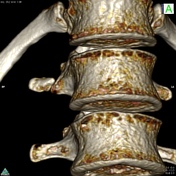Transverse process fracture
Updates to Article Attributes
Transverse process fractures are a common sequelae of trauma, although they are considered a minor and stable lumbar spine fracture. There is a strong association between transverse process fractures and other traumatic injuries.
Pathology
Transverse process fracture most commonly occuroccurs in the upper lumbar spine and are commonly multiple 2. The fracture line can extend into the transverse foramen, and in the cervical spine there is a risk of complicating vertebral artery dissection.
Aetiology
- blunt trauma
- lateral flexion-extension injury
- psoas muscle avulsion
- Malgaigne pelvic fracture
Associations
Although a minor injury to the lumbar spine, transverse process fractures require major force:
- cervical transverse process fractures have a strong association with other cervical spine fractures 2 andblunt cerebrovascular injury
- ~35% (range 20-50%) of patients with lumbar transverse process fractures have hepatic and splenic injuries, genitourinary and/or diaphragmatic injuries 1
Radiographic features
CT is the modality of choice. Up to 60% of lumbar transverse process fractures identified on CT will be missed on plain radiographs 1.
Differential diagnosis
In the lumbar region, consider anatomical variants such as:
- hypoplastic 12th rib
-
non-fused lumbarunfused transverse process ossificationcentrescentre
-<p><strong>Transverse process fractures</strong> are a common sequelae of trauma, although they are considered a minor and stable <a href="/articles/lumbar-spine-fracture">lumbar spine fracture</a>. There is strong association between transverse process fractures and other traumatic injuries.</p><h4>Pathology</h4><p>Transverse process fracture most commonly occur in the upper <a href="/articles/lumbar-spine">lumbar spine</a> and are commonly multiple <sup>2</sup>. The fracture line can extend into the <a href="/articles/transverse-foramen">transverse foramen</a>, and in the cervical spine there is a risk of complicating <a href="/articles/vertebral-artery-dissection">vertebral artery dissection</a>.</p><h5>Aetiology</h5><ul>- +<p><strong>Transverse process fractures</strong> are common sequelae of trauma, although they are considered a minor and stable <a href="/articles/lumbar-spine-fracture">lumbar spine fracture</a>. There is a strong association between transverse process fractures and other traumatic injuries.</p><h4>Pathology</h4><p>Transverse process fracture most commonly occurs in the upper <a href="/articles/lumbar-spine">lumbar spine</a> and are commonly multiple <sup>2</sup>. The fracture line can extend into the <a href="/articles/transverse-foramen">transverse foramen</a>, and in the cervical spine there is a risk of complicating <a href="/articles/vertebral-artery-dissection">vertebral artery dissection</a>.</p><h5>Aetiology</h5><ul>
-<a href="/articles/psoas-major-1">psoas muscle</a> avulsion</li>- +<a href="/articles/psoas-major-muscle-1">psoas muscle</a> avulsion</li>
-<li>hypoplastic 12th rib</li>-<li>non-fused lumbar transverse process ossification centres</li>- +<li>hypoplastic <a title="12th rib" href="/articles/twelfth-rib">12th rib</a>
- +</li>
- +<li><a title="unfused transverse process ossification centre" href="/articles/unfused-transverse-process-ossification-centre">unfused transverse process ossification centre</a></li>
Image 6 CT (bone window) ( create )








 Unable to process the form. Check for errors and try again.
Unable to process the form. Check for errors and try again.